A Report on Climate Change Impacts Affecting Great Ocean Road Tourism
VerifiedAdded on 2020/04/07
|14
|4544
|78
Report
AI Summary
This report investigates the multifaceted impacts of climate change on the tourism sector of the Great Ocean Road in Australia. It highlights the challenges posed by rising sea levels, extreme weather events, and shifts in climate patterns, which threaten coastal infrastructure, natural attractions, and visitor numbers. The report examines the economic, social, and environmental consequences, including the loss of income and employment opportunities. It discusses the driving issues such as global warming and the melting of snow and glaciers, which have led to increased sea levels. The report also explores the need for new policies to address the risks and emphasizes the roles of the government and various stakeholders in mitigating the adverse effects of climate change. It further provides key trends influencing planning, such as the need for sustainable policies and guidelines. The report concludes by advocating for proactive measures to minimize the environmental impacts and ensure the long-term viability of tourism in the Great Ocean Road region.
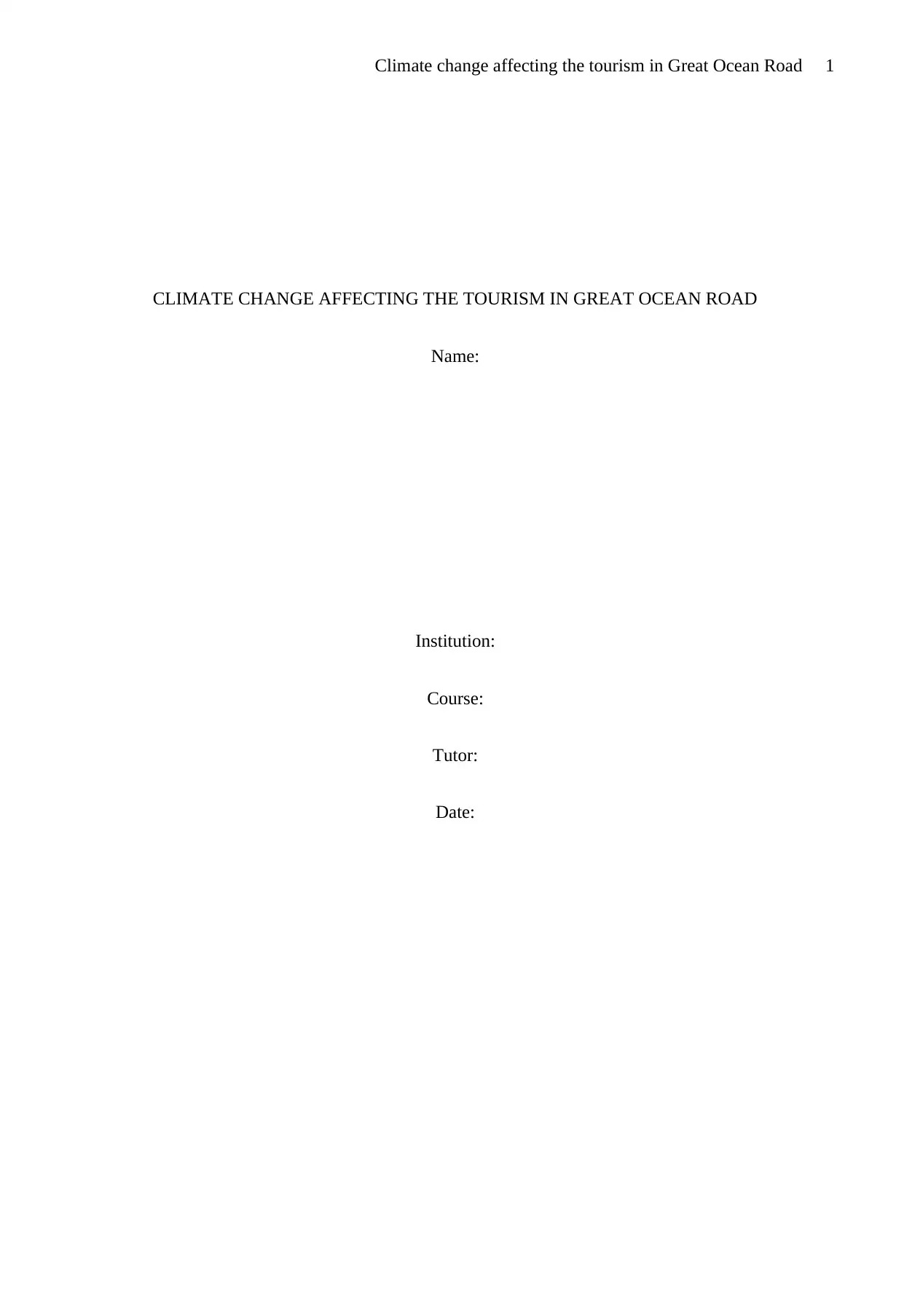
Climate change affecting the tourism in Great Ocean Road 1
CLIMATE CHANGE AFFECTING THE TOURISM IN GREAT OCEAN ROAD
Name:
Institution:
Course:
Tutor:
Date:
CLIMATE CHANGE AFFECTING THE TOURISM IN GREAT OCEAN ROAD
Name:
Institution:
Course:
Tutor:
Date:
Secure Best Marks with AI Grader
Need help grading? Try our AI Grader for instant feedback on your assignments.
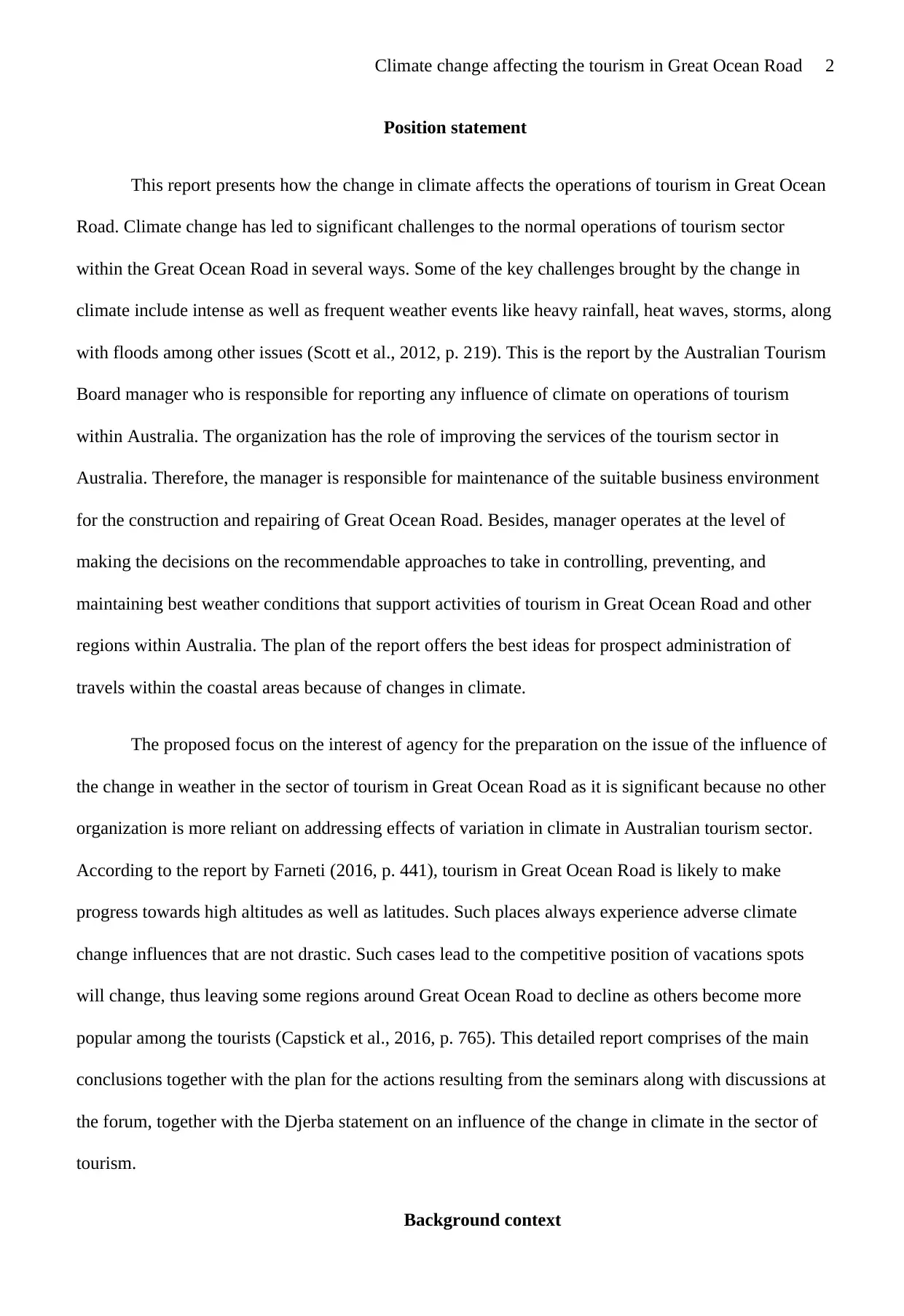
Climate change affecting the tourism in Great Ocean Road 2
Position statement
This report presents how the change in climate affects the operations of tourism in Great Ocean
Road. Climate change has led to significant challenges to the normal operations of tourism sector
within the Great Ocean Road in several ways. Some of the key challenges brought by the change in
climate include intense as well as frequent weather events like heavy rainfall, heat waves, storms, along
with floods among other issues (Scott et al., 2012, p. 219). This is the report by the Australian Tourism
Board manager who is responsible for reporting any influence of climate on operations of tourism
within Australia. The organization has the role of improving the services of the tourism sector in
Australia. Therefore, the manager is responsible for maintenance of the suitable business environment
for the construction and repairing of Great Ocean Road. Besides, manager operates at the level of
making the decisions on the recommendable approaches to take in controlling, preventing, and
maintaining best weather conditions that support activities of tourism in Great Ocean Road and other
regions within Australia. The plan of the report offers the best ideas for prospect administration of
travels within the coastal areas because of changes in climate.
The proposed focus on the interest of agency for the preparation on the issue of the influence of
the change in weather in the sector of tourism in Great Ocean Road as it is significant because no other
organization is more reliant on addressing effects of variation in climate in Australian tourism sector.
According to the report by Farneti (2016, p. 441), tourism in Great Ocean Road is likely to make
progress towards high altitudes as well as latitudes. Such places always experience adverse climate
change influences that are not drastic. Such cases lead to the competitive position of vacations spots
will change, thus leaving some regions around Great Ocean Road to decline as others become more
popular among the tourists (Capstick et al., 2016, p. 765). This detailed report comprises of the main
conclusions together with the plan for the actions resulting from the seminars along with discussions at
the forum, together with the Djerba statement on an influence of the change in climate in the sector of
tourism.
Background context
Position statement
This report presents how the change in climate affects the operations of tourism in Great Ocean
Road. Climate change has led to significant challenges to the normal operations of tourism sector
within the Great Ocean Road in several ways. Some of the key challenges brought by the change in
climate include intense as well as frequent weather events like heavy rainfall, heat waves, storms, along
with floods among other issues (Scott et al., 2012, p. 219). This is the report by the Australian Tourism
Board manager who is responsible for reporting any influence of climate on operations of tourism
within Australia. The organization has the role of improving the services of the tourism sector in
Australia. Therefore, the manager is responsible for maintenance of the suitable business environment
for the construction and repairing of Great Ocean Road. Besides, manager operates at the level of
making the decisions on the recommendable approaches to take in controlling, preventing, and
maintaining best weather conditions that support activities of tourism in Great Ocean Road and other
regions within Australia. The plan of the report offers the best ideas for prospect administration of
travels within the coastal areas because of changes in climate.
The proposed focus on the interest of agency for the preparation on the issue of the influence of
the change in weather in the sector of tourism in Great Ocean Road as it is significant because no other
organization is more reliant on addressing effects of variation in climate in Australian tourism sector.
According to the report by Farneti (2016, p. 441), tourism in Great Ocean Road is likely to make
progress towards high altitudes as well as latitudes. Such places always experience adverse climate
change influences that are not drastic. Such cases lead to the competitive position of vacations spots
will change, thus leaving some regions around Great Ocean Road to decline as others become more
popular among the tourists (Capstick et al., 2016, p. 765). This detailed report comprises of the main
conclusions together with the plan for the actions resulting from the seminars along with discussions at
the forum, together with the Djerba statement on an influence of the change in climate in the sector of
tourism.
Background context
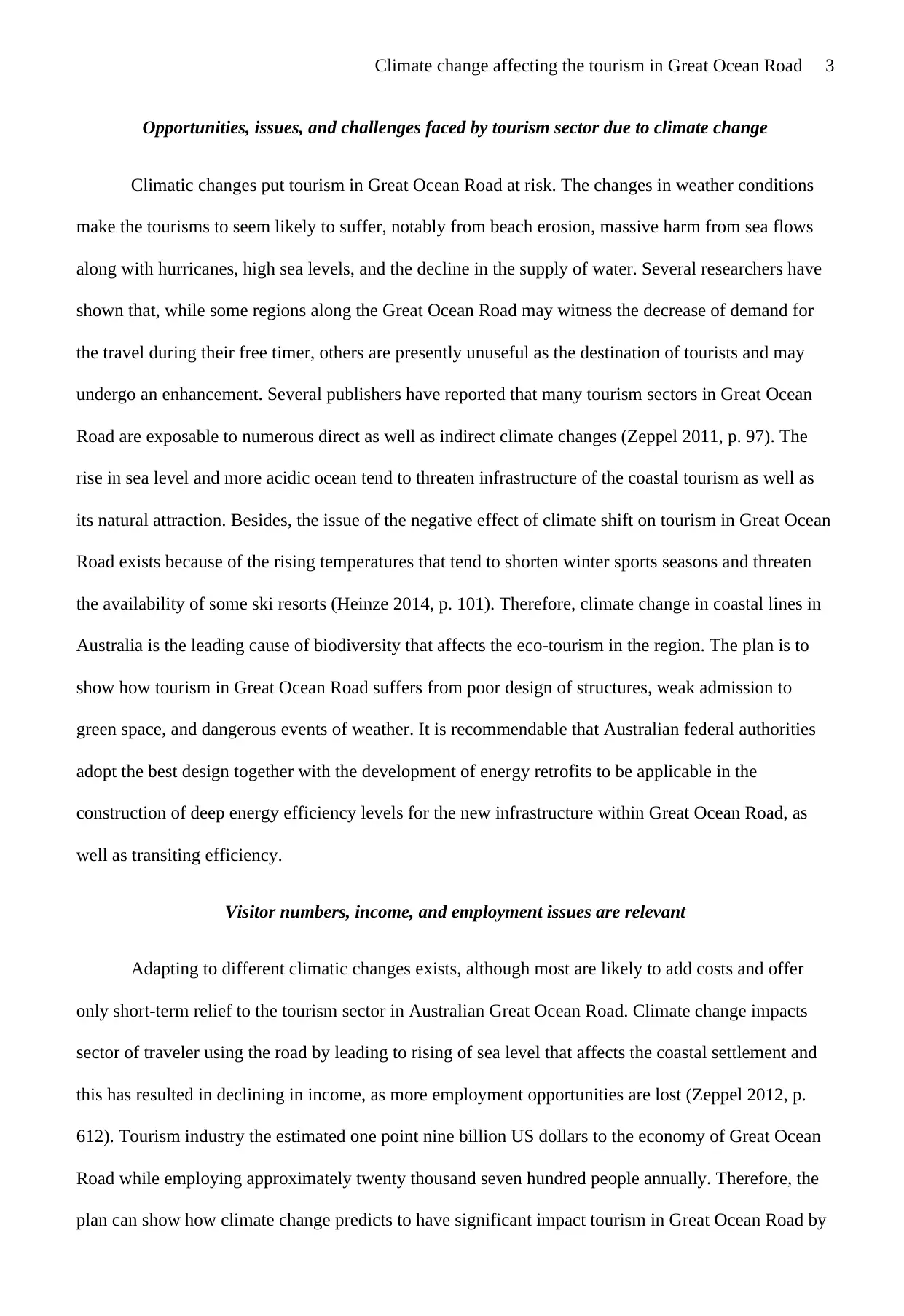
Climate change affecting the tourism in Great Ocean Road 3
Opportunities, issues, and challenges faced by tourism sector due to climate change
Climatic changes put tourism in Great Ocean Road at risk. The changes in weather conditions
make the tourisms to seem likely to suffer, notably from beach erosion, massive harm from sea flows
along with hurricanes, high sea levels, and the decline in the supply of water. Several researchers have
shown that, while some regions along the Great Ocean Road may witness the decrease of demand for
the travel during their free timer, others are presently unuseful as the destination of tourists and may
undergo an enhancement. Several publishers have reported that many tourism sectors in Great Ocean
Road are exposable to numerous direct as well as indirect climate changes (Zeppel 2011, p. 97). The
rise in sea level and more acidic ocean tend to threaten infrastructure of the coastal tourism as well as
its natural attraction. Besides, the issue of the negative effect of climate shift on tourism in Great Ocean
Road exists because of the rising temperatures that tend to shorten winter sports seasons and threaten
the availability of some ski resorts (Heinze 2014, p. 101). Therefore, climate change in coastal lines in
Australia is the leading cause of biodiversity that affects the eco-tourism in the region. The plan is to
show how tourism in Great Ocean Road suffers from poor design of structures, weak admission to
green space, and dangerous events of weather. It is recommendable that Australian federal authorities
adopt the best design together with the development of energy retrofits to be applicable in the
construction of deep energy efficiency levels for the new infrastructure within Great Ocean Road, as
well as transiting efficiency.
Visitor numbers, income, and employment issues are relevant
Adapting to different climatic changes exists, although most are likely to add costs and offer
only short-term relief to the tourism sector in Australian Great Ocean Road. Climate change impacts
sector of traveler using the road by leading to rising of sea level that affects the coastal settlement and
this has resulted in declining in income, as more employment opportunities are lost (Zeppel 2012, p.
612). Tourism industry the estimated one point nine billion US dollars to the economy of Great Ocean
Road while employing approximately twenty thousand seven hundred people annually. Therefore, the
plan can show how climate change predicts to have significant impact tourism in Great Ocean Road by
Opportunities, issues, and challenges faced by tourism sector due to climate change
Climatic changes put tourism in Great Ocean Road at risk. The changes in weather conditions
make the tourisms to seem likely to suffer, notably from beach erosion, massive harm from sea flows
along with hurricanes, high sea levels, and the decline in the supply of water. Several researchers have
shown that, while some regions along the Great Ocean Road may witness the decrease of demand for
the travel during their free timer, others are presently unuseful as the destination of tourists and may
undergo an enhancement. Several publishers have reported that many tourism sectors in Great Ocean
Road are exposable to numerous direct as well as indirect climate changes (Zeppel 2011, p. 97). The
rise in sea level and more acidic ocean tend to threaten infrastructure of the coastal tourism as well as
its natural attraction. Besides, the issue of the negative effect of climate shift on tourism in Great Ocean
Road exists because of the rising temperatures that tend to shorten winter sports seasons and threaten
the availability of some ski resorts (Heinze 2014, p. 101). Therefore, climate change in coastal lines in
Australia is the leading cause of biodiversity that affects the eco-tourism in the region. The plan is to
show how tourism in Great Ocean Road suffers from poor design of structures, weak admission to
green space, and dangerous events of weather. It is recommendable that Australian federal authorities
adopt the best design together with the development of energy retrofits to be applicable in the
construction of deep energy efficiency levels for the new infrastructure within Great Ocean Road, as
well as transiting efficiency.
Visitor numbers, income, and employment issues are relevant
Adapting to different climatic changes exists, although most are likely to add costs and offer
only short-term relief to the tourism sector in Australian Great Ocean Road. Climate change impacts
sector of traveler using the road by leading to rising of sea level that affects the coastal settlement and
this has resulted in declining in income, as more employment opportunities are lost (Zeppel 2012, p.
612). Tourism industry the estimated one point nine billion US dollars to the economy of Great Ocean
Road while employing approximately twenty thousand seven hundred people annually. Therefore, the
plan can show how climate change predicts to have significant impact tourism in Great Ocean Road by
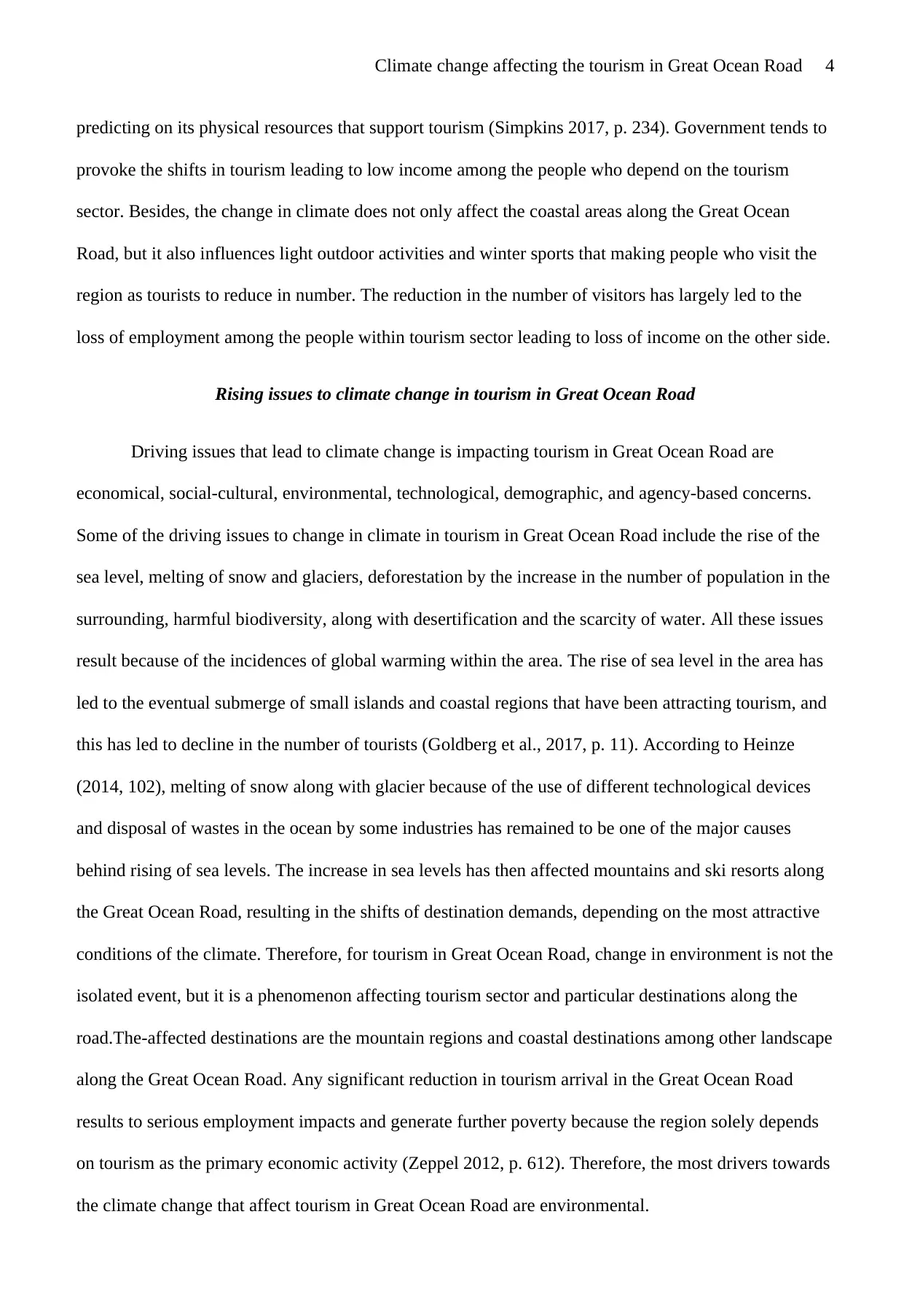
Climate change affecting the tourism in Great Ocean Road 4
predicting on its physical resources that support tourism (Simpkins 2017, p. 234). Government tends to
provoke the shifts in tourism leading to low income among the people who depend on the tourism
sector. Besides, the change in climate does not only affect the coastal areas along the Great Ocean
Road, but it also influences light outdoor activities and winter sports that making people who visit the
region as tourists to reduce in number. The reduction in the number of visitors has largely led to the
loss of employment among the people within tourism sector leading to loss of income on the other side.
Rising issues to climate change in tourism in Great Ocean Road
Driving issues that lead to climate change is impacting tourism in Great Ocean Road are
economical, social-cultural, environmental, technological, demographic, and agency-based concerns.
Some of the driving issues to change in climate in tourism in Great Ocean Road include the rise of the
sea level, melting of snow and glaciers, deforestation by the increase in the number of population in the
surrounding, harmful biodiversity, along with desertification and the scarcity of water. All these issues
result because of the incidences of global warming within the area. The rise of sea level in the area has
led to the eventual submerge of small islands and coastal regions that have been attracting tourism, and
this has led to decline in the number of tourists (Goldberg et al., 2017, p. 11). According to Heinze
(2014, 102), melting of snow along with glacier because of the use of different technological devices
and disposal of wastes in the ocean by some industries has remained to be one of the major causes
behind rising of sea levels. The increase in sea levels has then affected mountains and ski resorts along
the Great Ocean Road, resulting in the shifts of destination demands, depending on the most attractive
conditions of the climate. Therefore, for tourism in Great Ocean Road, change in environment is not the
isolated event, but it is a phenomenon affecting tourism sector and particular destinations along the
road.The-affected destinations are the mountain regions and coastal destinations among other landscape
along the Great Ocean Road. Any significant reduction in tourism arrival in the Great Ocean Road
results to serious employment impacts and generate further poverty because the region solely depends
on tourism as the primary economic activity (Zeppel 2012, p. 612). Therefore, the most drivers towards
the climate change that affect tourism in Great Ocean Road are environmental.
predicting on its physical resources that support tourism (Simpkins 2017, p. 234). Government tends to
provoke the shifts in tourism leading to low income among the people who depend on the tourism
sector. Besides, the change in climate does not only affect the coastal areas along the Great Ocean
Road, but it also influences light outdoor activities and winter sports that making people who visit the
region as tourists to reduce in number. The reduction in the number of visitors has largely led to the
loss of employment among the people within tourism sector leading to loss of income on the other side.
Rising issues to climate change in tourism in Great Ocean Road
Driving issues that lead to climate change is impacting tourism in Great Ocean Road are
economical, social-cultural, environmental, technological, demographic, and agency-based concerns.
Some of the driving issues to change in climate in tourism in Great Ocean Road include the rise of the
sea level, melting of snow and glaciers, deforestation by the increase in the number of population in the
surrounding, harmful biodiversity, along with desertification and the scarcity of water. All these issues
result because of the incidences of global warming within the area. The rise of sea level in the area has
led to the eventual submerge of small islands and coastal regions that have been attracting tourism, and
this has led to decline in the number of tourists (Goldberg et al., 2017, p. 11). According to Heinze
(2014, 102), melting of snow along with glacier because of the use of different technological devices
and disposal of wastes in the ocean by some industries has remained to be one of the major causes
behind rising of sea levels. The increase in sea levels has then affected mountains and ski resorts along
the Great Ocean Road, resulting in the shifts of destination demands, depending on the most attractive
conditions of the climate. Therefore, for tourism in Great Ocean Road, change in environment is not the
isolated event, but it is a phenomenon affecting tourism sector and particular destinations along the
road.The-affected destinations are the mountain regions and coastal destinations among other landscape
along the Great Ocean Road. Any significant reduction in tourism arrival in the Great Ocean Road
results to serious employment impacts and generate further poverty because the region solely depends
on tourism as the primary economic activity (Zeppel 2012, p. 612). Therefore, the most drivers towards
the climate change that affect tourism in Great Ocean Road are environmental.
Secure Best Marks with AI Grader
Need help grading? Try our AI Grader for instant feedback on your assignments.
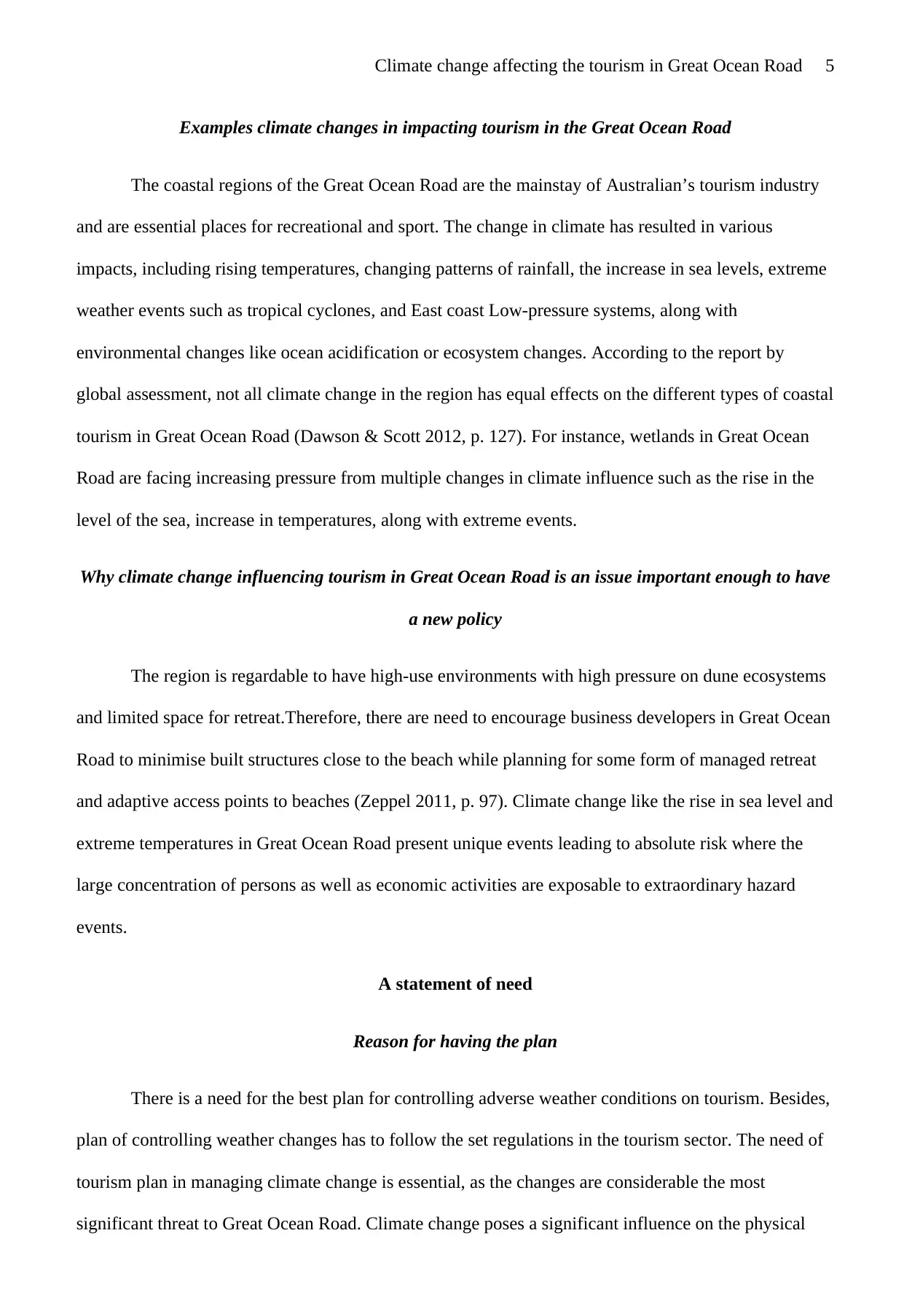
Climate change affecting the tourism in Great Ocean Road 5
Examples climate changes in impacting tourism in the Great Ocean Road
The coastal regions of the Great Ocean Road are the mainstay of Australian’s tourism industry
and are essential places for recreational and sport. The change in climate has resulted in various
impacts, including rising temperatures, changing patterns of rainfall, the increase in sea levels, extreme
weather events such as tropical cyclones, and East coast Low-pressure systems, along with
environmental changes like ocean acidification or ecosystem changes. According to the report by
global assessment, not all climate change in the region has equal effects on the different types of coastal
tourism in Great Ocean Road (Dawson & Scott 2012, p. 127). For instance, wetlands in Great Ocean
Road are facing increasing pressure from multiple changes in climate influence such as the rise in the
level of the sea, increase in temperatures, along with extreme events.
Why climate change influencing tourism in Great Ocean Road is an issue important enough to have
a new policy
The region is regardable to have high-use environments with high pressure on dune ecosystems
and limited space for retreat.Therefore, there are need to encourage business developers in Great Ocean
Road to minimise built structures close to the beach while planning for some form of managed retreat
and adaptive access points to beaches (Zeppel 2011, p. 97). Climate change like the rise in sea level and
extreme temperatures in Great Ocean Road present unique events leading to absolute risk where the
large concentration of persons as well as economic activities are exposable to extraordinary hazard
events.
A statement of need
Reason for having the plan
There is a need for the best plan for controlling adverse weather conditions on tourism. Besides,
plan of controlling weather changes has to follow the set regulations in the tourism sector. The need of
tourism plan in managing climate change is essential, as the changes are considerable the most
significant threat to Great Ocean Road. Climate change poses a significant influence on the physical
Examples climate changes in impacting tourism in the Great Ocean Road
The coastal regions of the Great Ocean Road are the mainstay of Australian’s tourism industry
and are essential places for recreational and sport. The change in climate has resulted in various
impacts, including rising temperatures, changing patterns of rainfall, the increase in sea levels, extreme
weather events such as tropical cyclones, and East coast Low-pressure systems, along with
environmental changes like ocean acidification or ecosystem changes. According to the report by
global assessment, not all climate change in the region has equal effects on the different types of coastal
tourism in Great Ocean Road (Dawson & Scott 2012, p. 127). For instance, wetlands in Great Ocean
Road are facing increasing pressure from multiple changes in climate influence such as the rise in the
level of the sea, increase in temperatures, along with extreme events.
Why climate change influencing tourism in Great Ocean Road is an issue important enough to have
a new policy
The region is regardable to have high-use environments with high pressure on dune ecosystems
and limited space for retreat.Therefore, there are need to encourage business developers in Great Ocean
Road to minimise built structures close to the beach while planning for some form of managed retreat
and adaptive access points to beaches (Zeppel 2011, p. 97). Climate change like the rise in sea level and
extreme temperatures in Great Ocean Road present unique events leading to absolute risk where the
large concentration of persons as well as economic activities are exposable to extraordinary hazard
events.
A statement of need
Reason for having the plan
There is a need for the best plan for controlling adverse weather conditions on tourism. Besides,
plan of controlling weather changes has to follow the set regulations in the tourism sector. The need of
tourism plan in managing climate change is essential, as the changes are considerable the most
significant threat to Great Ocean Road. Climate change poses a significant influence on the physical
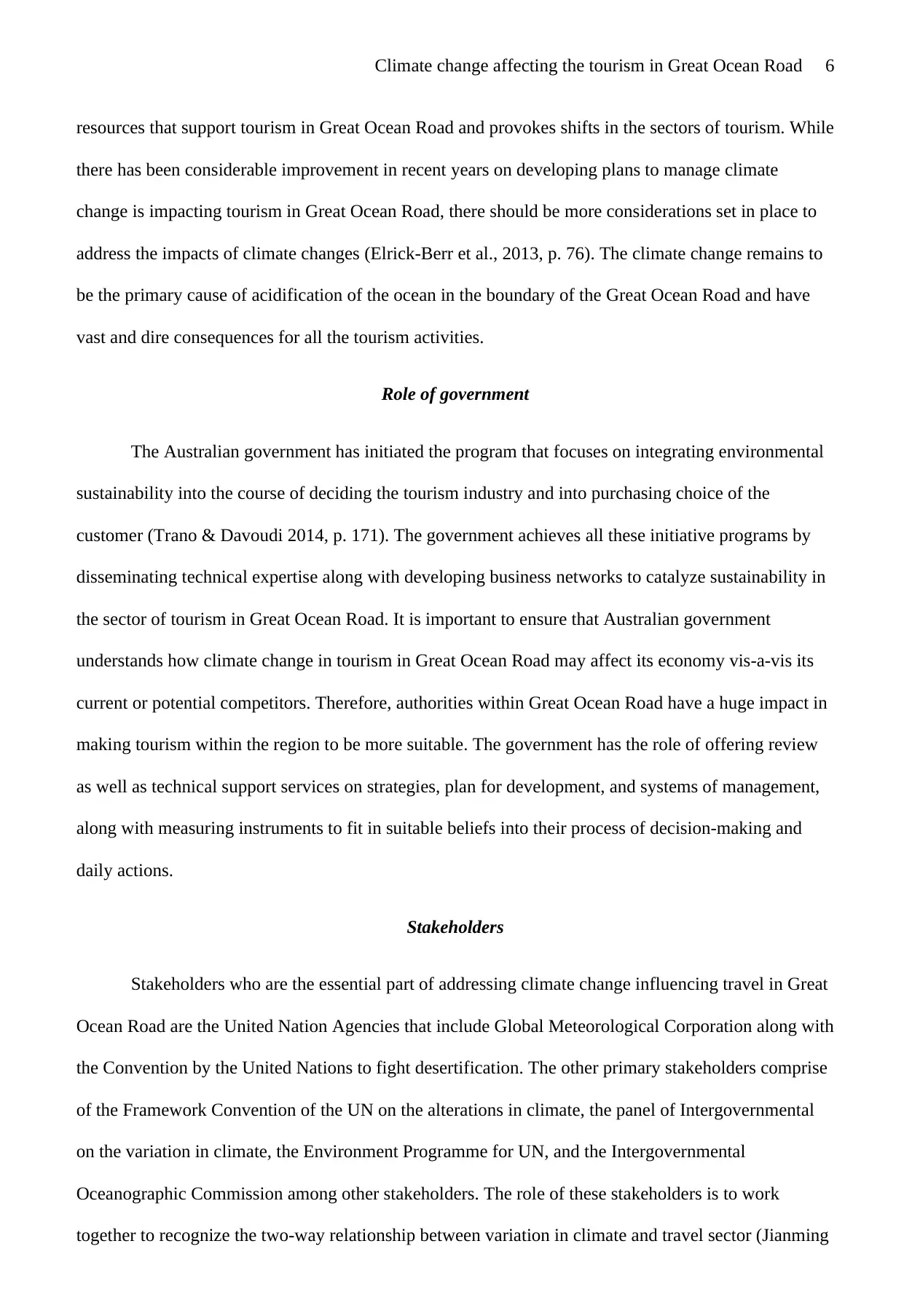
Climate change affecting the tourism in Great Ocean Road 6
resources that support tourism in Great Ocean Road and provokes shifts in the sectors of tourism. While
there has been considerable improvement in recent years on developing plans to manage climate
change is impacting tourism in Great Ocean Road, there should be more considerations set in place to
address the impacts of climate changes (Elrick-Berr et al., 2013, p. 76). The climate change remains to
be the primary cause of acidification of the ocean in the boundary of the Great Ocean Road and have
vast and dire consequences for all the tourism activities.
Role of government
The Australian government has initiated the program that focuses on integrating environmental
sustainability into the course of deciding the tourism industry and into purchasing choice of the
customer (Trano & Davoudi 2014, p. 171). The government achieves all these initiative programs by
disseminating technical expertise along with developing business networks to catalyze sustainability in
the sector of tourism in Great Ocean Road. It is important to ensure that Australian government
understands how climate change in tourism in Great Ocean Road may affect its economy vis-a-vis its
current or potential competitors. Therefore, authorities within Great Ocean Road have a huge impact in
making tourism within the region to be more suitable. The government has the role of offering review
as well as technical support services on strategies, plan for development, and systems of management,
along with measuring instruments to fit in suitable beliefs into their process of decision-making and
daily actions.
Stakeholders
Stakeholders who are the essential part of addressing climate change influencing travel in Great
Ocean Road are the United Nation Agencies that include Global Meteorological Corporation along with
the Convention by the United Nations to fight desertification. The other primary stakeholders comprise
of the Framework Convention of the UN on the alterations in climate, the panel of Intergovernmental
on the variation in climate, the Environment Programme for UN, and the Intergovernmental
Oceanographic Commission among other stakeholders. The role of these stakeholders is to work
together to recognize the two-way relationship between variation in climate and travel sector (Jianming
resources that support tourism in Great Ocean Road and provokes shifts in the sectors of tourism. While
there has been considerable improvement in recent years on developing plans to manage climate
change is impacting tourism in Great Ocean Road, there should be more considerations set in place to
address the impacts of climate changes (Elrick-Berr et al., 2013, p. 76). The climate change remains to
be the primary cause of acidification of the ocean in the boundary of the Great Ocean Road and have
vast and dire consequences for all the tourism activities.
Role of government
The Australian government has initiated the program that focuses on integrating environmental
sustainability into the course of deciding the tourism industry and into purchasing choice of the
customer (Trano & Davoudi 2014, p. 171). The government achieves all these initiative programs by
disseminating technical expertise along with developing business networks to catalyze sustainability in
the sector of tourism in Great Ocean Road. It is important to ensure that Australian government
understands how climate change in tourism in Great Ocean Road may affect its economy vis-a-vis its
current or potential competitors. Therefore, authorities within Great Ocean Road have a huge impact in
making tourism within the region to be more suitable. The government has the role of offering review
as well as technical support services on strategies, plan for development, and systems of management,
along with measuring instruments to fit in suitable beliefs into their process of decision-making and
daily actions.
Stakeholders
Stakeholders who are the essential part of addressing climate change influencing travel in Great
Ocean Road are the United Nation Agencies that include Global Meteorological Corporation along with
the Convention by the United Nations to fight desertification. The other primary stakeholders comprise
of the Framework Convention of the UN on the alterations in climate, the panel of Intergovernmental
on the variation in climate, the Environment Programme for UN, and the Intergovernmental
Oceanographic Commission among other stakeholders. The role of these stakeholders is to work
together to recognize the two-way relationship between variation in climate and travel sector (Jianming
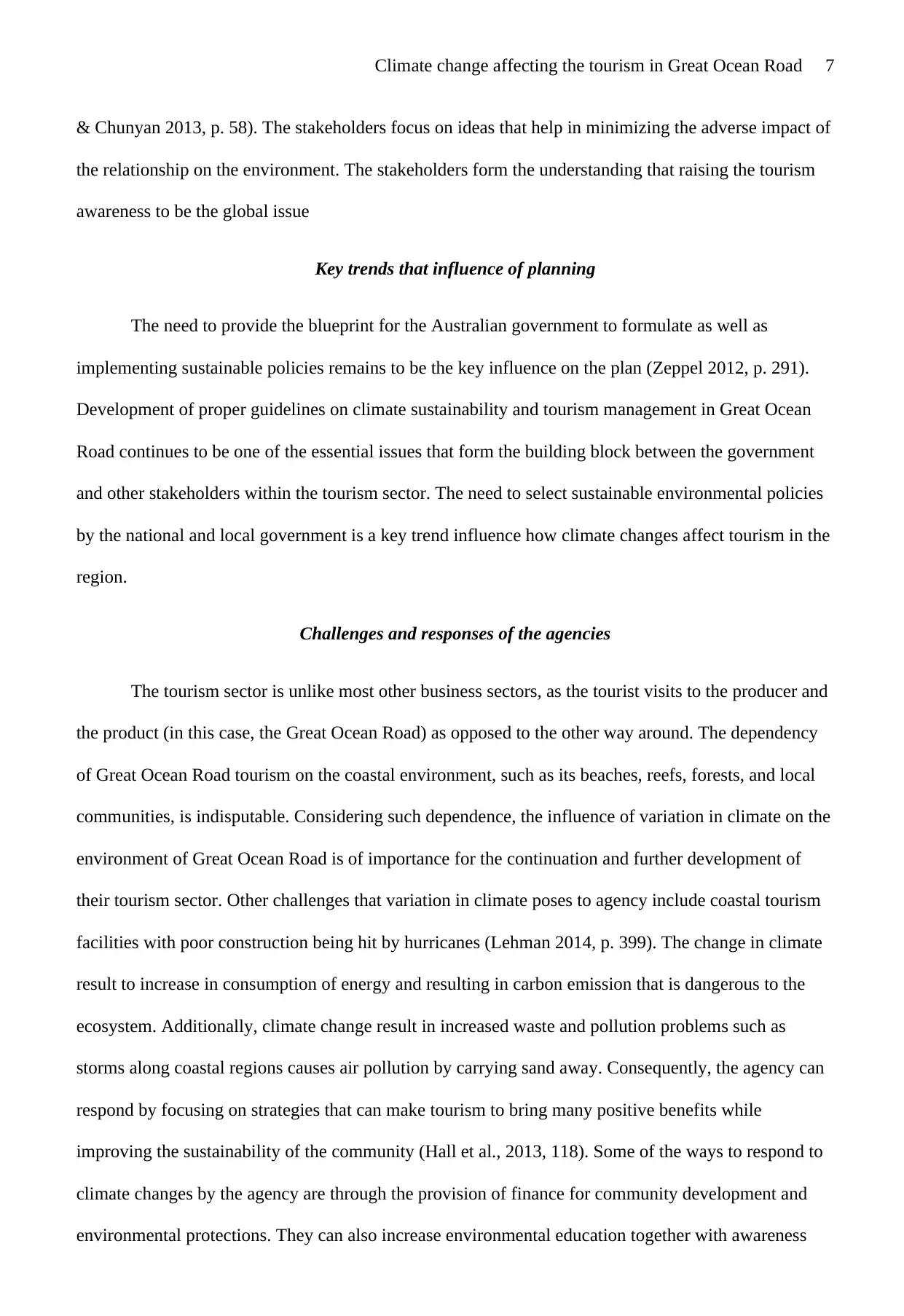
Climate change affecting the tourism in Great Ocean Road 7
& Chunyan 2013, p. 58). The stakeholders focus on ideas that help in minimizing the adverse impact of
the relationship on the environment. The stakeholders form the understanding that raising the tourism
awareness to be the global issue
Key trends that influence of planning
The need to provide the blueprint for the Australian government to formulate as well as
implementing sustainable policies remains to be the key influence on the plan (Zeppel 2012, p. 291).
Development of proper guidelines on climate sustainability and tourism management in Great Ocean
Road continues to be one of the essential issues that form the building block between the government
and other stakeholders within the tourism sector. The need to select sustainable environmental policies
by the national and local government is a key trend influence how climate changes affect tourism in the
region.
Challenges and responses of the agencies
The tourism sector is unlike most other business sectors, as the tourist visits to the producer and
the product (in this case, the Great Ocean Road) as opposed to the other way around. The dependency
of Great Ocean Road tourism on the coastal environment, such as its beaches, reefs, forests, and local
communities, is indisputable. Considering such dependence, the influence of variation in climate on the
environment of Great Ocean Road is of importance for the continuation and further development of
their tourism sector. Other challenges that variation in climate poses to agency include coastal tourism
facilities with poor construction being hit by hurricanes (Lehman 2014, p. 399). The change in climate
result to increase in consumption of energy and resulting in carbon emission that is dangerous to the
ecosystem. Additionally, climate change result in increased waste and pollution problems such as
storms along coastal regions causes air pollution by carrying sand away. Consequently, the agency can
respond by focusing on strategies that can make tourism to bring many positive benefits while
improving the sustainability of the community (Hall et al., 2013, 118). Some of the ways to respond to
climate changes by the agency are through the provision of finance for community development and
environmental protections. They can also increase environmental education together with awareness
& Chunyan 2013, p. 58). The stakeholders focus on ideas that help in minimizing the adverse impact of
the relationship on the environment. The stakeholders form the understanding that raising the tourism
awareness to be the global issue
Key trends that influence of planning
The need to provide the blueprint for the Australian government to formulate as well as
implementing sustainable policies remains to be the key influence on the plan (Zeppel 2012, p. 291).
Development of proper guidelines on climate sustainability and tourism management in Great Ocean
Road continues to be one of the essential issues that form the building block between the government
and other stakeholders within the tourism sector. The need to select sustainable environmental policies
by the national and local government is a key trend influence how climate changes affect tourism in the
region.
Challenges and responses of the agencies
The tourism sector is unlike most other business sectors, as the tourist visits to the producer and
the product (in this case, the Great Ocean Road) as opposed to the other way around. The dependency
of Great Ocean Road tourism on the coastal environment, such as its beaches, reefs, forests, and local
communities, is indisputable. Considering such dependence, the influence of variation in climate on the
environment of Great Ocean Road is of importance for the continuation and further development of
their tourism sector. Other challenges that variation in climate poses to agency include coastal tourism
facilities with poor construction being hit by hurricanes (Lehman 2014, p. 399). The change in climate
result to increase in consumption of energy and resulting in carbon emission that is dangerous to the
ecosystem. Additionally, climate change result in increased waste and pollution problems such as
storms along coastal regions causes air pollution by carrying sand away. Consequently, the agency can
respond by focusing on strategies that can make tourism to bring many positive benefits while
improving the sustainability of the community (Hall et al., 2013, 118). Some of the ways to respond to
climate changes by the agency are through the provision of finance for community development and
environmental protections. They can also increase environmental education together with awareness
Paraphrase This Document
Need a fresh take? Get an instant paraphrase of this document with our AI Paraphraser
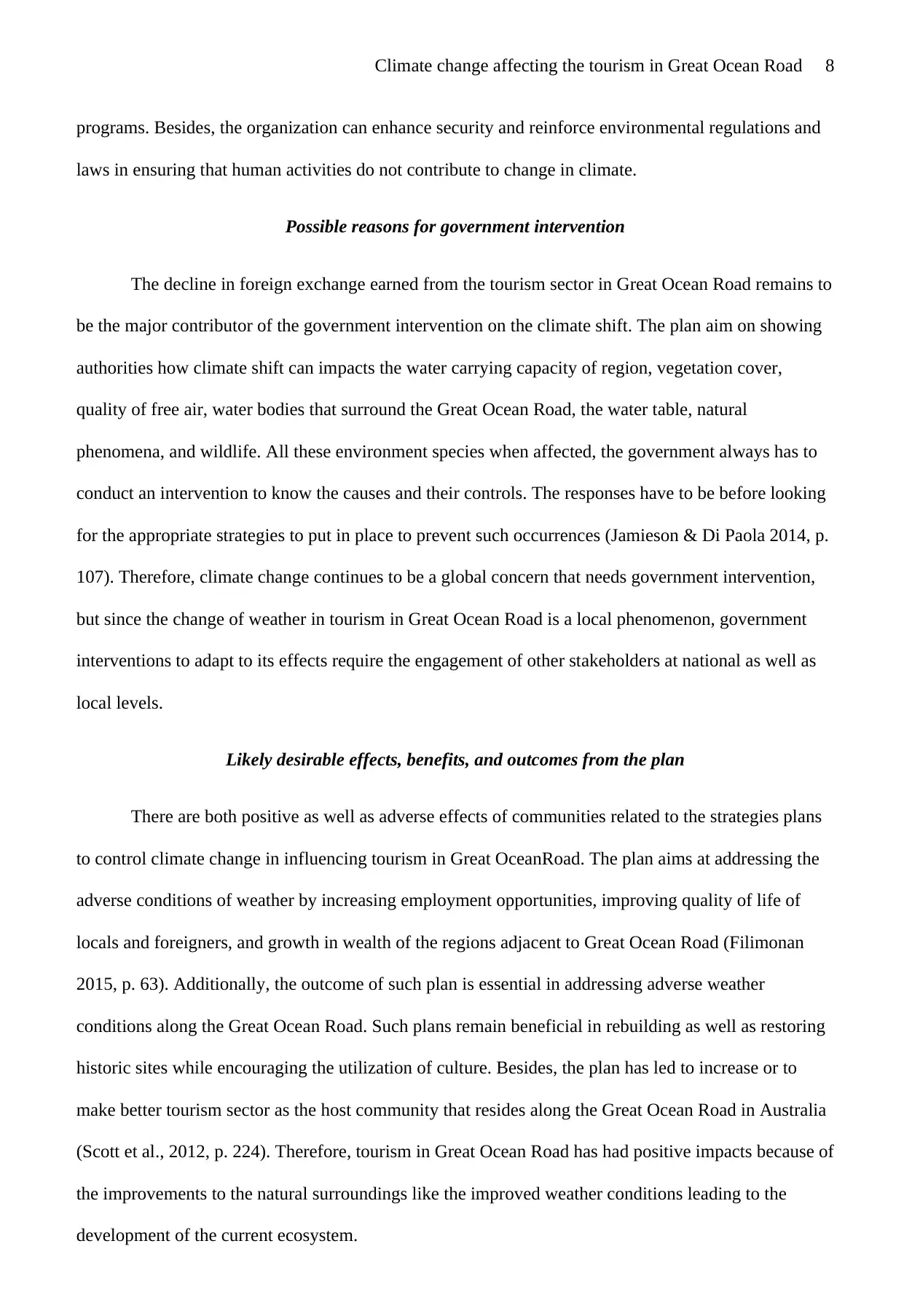
Climate change affecting the tourism in Great Ocean Road 8
programs. Besides, the organization can enhance security and reinforce environmental regulations and
laws in ensuring that human activities do not contribute to change in climate.
Possible reasons for government intervention
The decline in foreign exchange earned from the tourism sector in Great Ocean Road remains to
be the major contributor of the government intervention on the climate shift. The plan aim on showing
authorities how climate shift can impacts the water carrying capacity of region, vegetation cover,
quality of free air, water bodies that surround the Great Ocean Road, the water table, natural
phenomena, and wildlife. All these environment species when affected, the government always has to
conduct an intervention to know the causes and their controls. The responses have to be before looking
for the appropriate strategies to put in place to prevent such occurrences (Jamieson & Di Paola 2014, p.
107). Therefore, climate change continues to be a global concern that needs government intervention,
but since the change of weather in tourism in Great Ocean Road is a local phenomenon, government
interventions to adapt to its effects require the engagement of other stakeholders at national as well as
local levels.
Likely desirable effects, benefits, and outcomes from the plan
There are both positive as well as adverse effects of communities related to the strategies plans
to control climate change in influencing tourism in Great OceanRoad. The plan aims at addressing the
adverse conditions of weather by increasing employment opportunities, improving quality of life of
locals and foreigners, and growth in wealth of the regions adjacent to Great Ocean Road (Filimonan
2015, p. 63). Additionally, the outcome of such plan is essential in addressing adverse weather
conditions along the Great Ocean Road. Such plans remain beneficial in rebuilding as well as restoring
historic sites while encouraging the utilization of culture. Besides, the plan has led to increase or to
make better tourism sector as the host community that resides along the Great Ocean Road in Australia
(Scott et al., 2012, p. 224). Therefore, tourism in Great Ocean Road has had positive impacts because of
the improvements to the natural surroundings like the improved weather conditions leading to the
development of the current ecosystem.
programs. Besides, the organization can enhance security and reinforce environmental regulations and
laws in ensuring that human activities do not contribute to change in climate.
Possible reasons for government intervention
The decline in foreign exchange earned from the tourism sector in Great Ocean Road remains to
be the major contributor of the government intervention on the climate shift. The plan aim on showing
authorities how climate shift can impacts the water carrying capacity of region, vegetation cover,
quality of free air, water bodies that surround the Great Ocean Road, the water table, natural
phenomena, and wildlife. All these environment species when affected, the government always has to
conduct an intervention to know the causes and their controls. The responses have to be before looking
for the appropriate strategies to put in place to prevent such occurrences (Jamieson & Di Paola 2014, p.
107). Therefore, climate change continues to be a global concern that needs government intervention,
but since the change of weather in tourism in Great Ocean Road is a local phenomenon, government
interventions to adapt to its effects require the engagement of other stakeholders at national as well as
local levels.
Likely desirable effects, benefits, and outcomes from the plan
There are both positive as well as adverse effects of communities related to the strategies plans
to control climate change in influencing tourism in Great OceanRoad. The plan aims at addressing the
adverse conditions of weather by increasing employment opportunities, improving quality of life of
locals and foreigners, and growth in wealth of the regions adjacent to Great Ocean Road (Filimonan
2015, p. 63). Additionally, the outcome of such plan is essential in addressing adverse weather
conditions along the Great Ocean Road. Such plans remain beneficial in rebuilding as well as restoring
historic sites while encouraging the utilization of culture. Besides, the plan has led to increase or to
make better tourism sector as the host community that resides along the Great Ocean Road in Australia
(Scott et al., 2012, p. 224). Therefore, tourism in Great Ocean Road has had positive impacts because of
the improvements to the natural surroundings like the improved weather conditions leading to the
development of the current ecosystem.
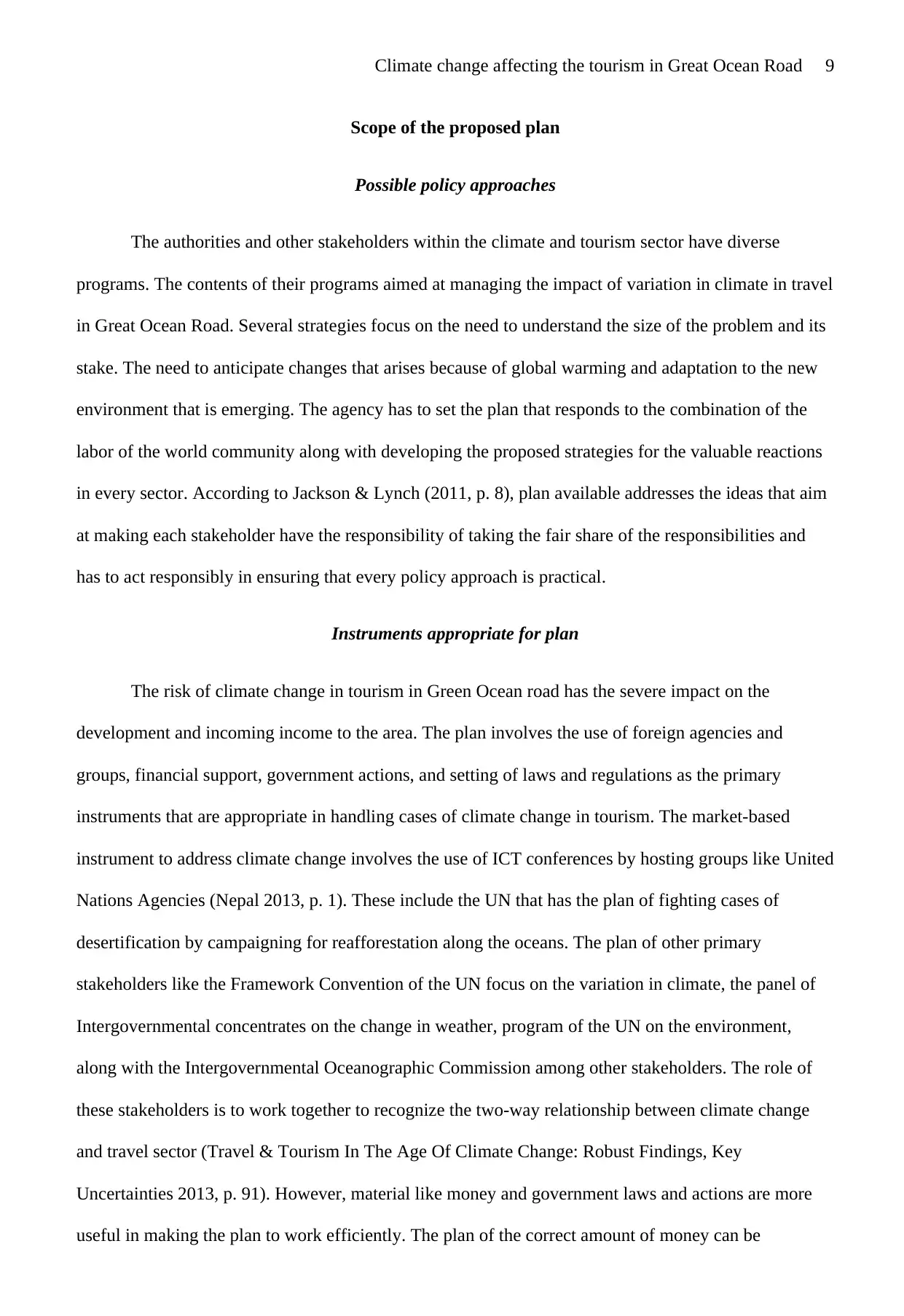
Climate change affecting the tourism in Great Ocean Road 9
Scope of the proposed plan
Possible policy approaches
The authorities and other stakeholders within the climate and tourism sector have diverse
programs. The contents of their programs aimed at managing the impact of variation in climate in travel
in Great Ocean Road. Several strategies focus on the need to understand the size of the problem and its
stake. The need to anticipate changes that arises because of global warming and adaptation to the new
environment that is emerging. The agency has to set the plan that responds to the combination of the
labor of the world community along with developing the proposed strategies for the valuable reactions
in every sector. According to Jackson & Lynch (2011, p. 8), plan available addresses the ideas that aim
at making each stakeholder have the responsibility of taking the fair share of the responsibilities and
has to act responsibly in ensuring that every policy approach is practical.
Instruments appropriate for plan
The risk of climate change in tourism in Green Ocean road has the severe impact on the
development and incoming income to the area. The plan involves the use of foreign agencies and
groups, financial support, government actions, and setting of laws and regulations as the primary
instruments that are appropriate in handling cases of climate change in tourism. The market-based
instrument to address climate change involves the use of ICT conferences by hosting groups like United
Nations Agencies (Nepal 2013, p. 1). These include the UN that has the plan of fighting cases of
desertification by campaigning for reafforestation along the oceans. The plan of other primary
stakeholders like the Framework Convention of the UN focus on the variation in climate, the panel of
Intergovernmental concentrates on the change in weather, program of the UN on the environment,
along with the Intergovernmental Oceanographic Commission among other stakeholders. The role of
these stakeholders is to work together to recognize the two-way relationship between climate change
and travel sector (Travel & Tourism In The Age Of Climate Change: Robust Findings, Key
Uncertainties 2013, p. 91). However, material like money and government laws and actions are more
useful in making the plan to work efficiently. The plan of the correct amount of money can be
Scope of the proposed plan
Possible policy approaches
The authorities and other stakeholders within the climate and tourism sector have diverse
programs. The contents of their programs aimed at managing the impact of variation in climate in travel
in Great Ocean Road. Several strategies focus on the need to understand the size of the problem and its
stake. The need to anticipate changes that arises because of global warming and adaptation to the new
environment that is emerging. The agency has to set the plan that responds to the combination of the
labor of the world community along with developing the proposed strategies for the valuable reactions
in every sector. According to Jackson & Lynch (2011, p. 8), plan available addresses the ideas that aim
at making each stakeholder have the responsibility of taking the fair share of the responsibilities and
has to act responsibly in ensuring that every policy approach is practical.
Instruments appropriate for plan
The risk of climate change in tourism in Green Ocean road has the severe impact on the
development and incoming income to the area. The plan involves the use of foreign agencies and
groups, financial support, government actions, and setting of laws and regulations as the primary
instruments that are appropriate in handling cases of climate change in tourism. The market-based
instrument to address climate change involves the use of ICT conferences by hosting groups like United
Nations Agencies (Nepal 2013, p. 1). These include the UN that has the plan of fighting cases of
desertification by campaigning for reafforestation along the oceans. The plan of other primary
stakeholders like the Framework Convention of the UN focus on the variation in climate, the panel of
Intergovernmental concentrates on the change in weather, program of the UN on the environment,
along with the Intergovernmental Oceanographic Commission among other stakeholders. The role of
these stakeholders is to work together to recognize the two-way relationship between climate change
and travel sector (Travel & Tourism In The Age Of Climate Change: Robust Findings, Key
Uncertainties 2013, p. 91). However, material like money and government laws and actions are more
useful in making the plan to work efficiently. The plan of the correct amount of money can be
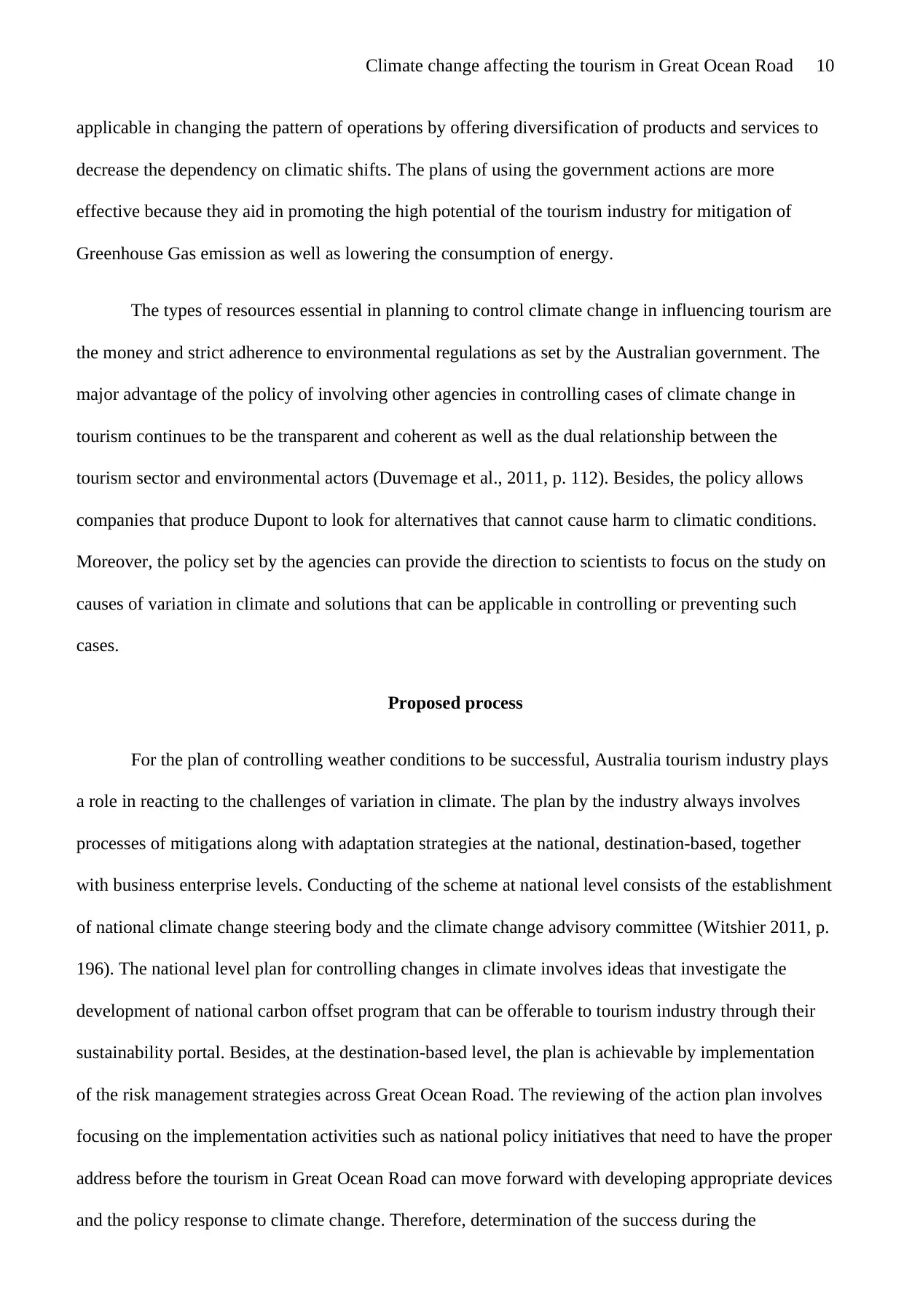
Climate change affecting the tourism in Great Ocean Road 10
applicable in changing the pattern of operations by offering diversification of products and services to
decrease the dependency on climatic shifts. The plans of using the government actions are more
effective because they aid in promoting the high potential of the tourism industry for mitigation of
Greenhouse Gas emission as well as lowering the consumption of energy.
The types of resources essential in planning to control climate change in influencing tourism are
the money and strict adherence to environmental regulations as set by the Australian government. The
major advantage of the policy of involving other agencies in controlling cases of climate change in
tourism continues to be the transparent and coherent as well as the dual relationship between the
tourism sector and environmental actors (Duvemage et al., 2011, p. 112). Besides, the policy allows
companies that produce Dupont to look for alternatives that cannot cause harm to climatic conditions.
Moreover, the policy set by the agencies can provide the direction to scientists to focus on the study on
causes of variation in climate and solutions that can be applicable in controlling or preventing such
cases.
Proposed process
For the plan of controlling weather conditions to be successful, Australia tourism industry plays
a role in reacting to the challenges of variation in climate. The plan by the industry always involves
processes of mitigations along with adaptation strategies at the national, destination-based, together
with business enterprise levels. Conducting of the scheme at national level consists of the establishment
of national climate change steering body and the climate change advisory committee (Witshier 2011, p.
196). The national level plan for controlling changes in climate involves ideas that investigate the
development of national carbon offset program that can be offerable to tourism industry through their
sustainability portal. Besides, at the destination-based level, the plan is achievable by implementation
of the risk management strategies across Great Ocean Road. The reviewing of the action plan involves
focusing on the implementation activities such as national policy initiatives that need to have the proper
address before the tourism in Great Ocean Road can move forward with developing appropriate devices
and the policy response to climate change. Therefore, determination of the success during the
applicable in changing the pattern of operations by offering diversification of products and services to
decrease the dependency on climatic shifts. The plans of using the government actions are more
effective because they aid in promoting the high potential of the tourism industry for mitigation of
Greenhouse Gas emission as well as lowering the consumption of energy.
The types of resources essential in planning to control climate change in influencing tourism are
the money and strict adherence to environmental regulations as set by the Australian government. The
major advantage of the policy of involving other agencies in controlling cases of climate change in
tourism continues to be the transparent and coherent as well as the dual relationship between the
tourism sector and environmental actors (Duvemage et al., 2011, p. 112). Besides, the policy allows
companies that produce Dupont to look for alternatives that cannot cause harm to climatic conditions.
Moreover, the policy set by the agencies can provide the direction to scientists to focus on the study on
causes of variation in climate and solutions that can be applicable in controlling or preventing such
cases.
Proposed process
For the plan of controlling weather conditions to be successful, Australia tourism industry plays
a role in reacting to the challenges of variation in climate. The plan by the industry always involves
processes of mitigations along with adaptation strategies at the national, destination-based, together
with business enterprise levels. Conducting of the scheme at national level consists of the establishment
of national climate change steering body and the climate change advisory committee (Witshier 2011, p.
196). The national level plan for controlling changes in climate involves ideas that investigate the
development of national carbon offset program that can be offerable to tourism industry through their
sustainability portal. Besides, at the destination-based level, the plan is achievable by implementation
of the risk management strategies across Great Ocean Road. The reviewing of the action plan involves
focusing on the implementation activities such as national policy initiatives that need to have the proper
address before the tourism in Great Ocean Road can move forward with developing appropriate devices
and the policy response to climate change. Therefore, determination of the success during the
Secure Best Marks with AI Grader
Need help grading? Try our AI Grader for instant feedback on your assignments.

Climate change affecting the tourism in Great Ocean Road 11
implementation of the plan is always evident in the increased or developed economies. It is also
apparent through the development of scientific ideas along with technological capabilities of the
tourism sector in Great Ocean when compared to previous years.
implementation of the plan is always evident in the increased or developed economies. It is also
apparent through the development of scientific ideas along with technological capabilities of the
tourism sector in Great Ocean when compared to previous years.
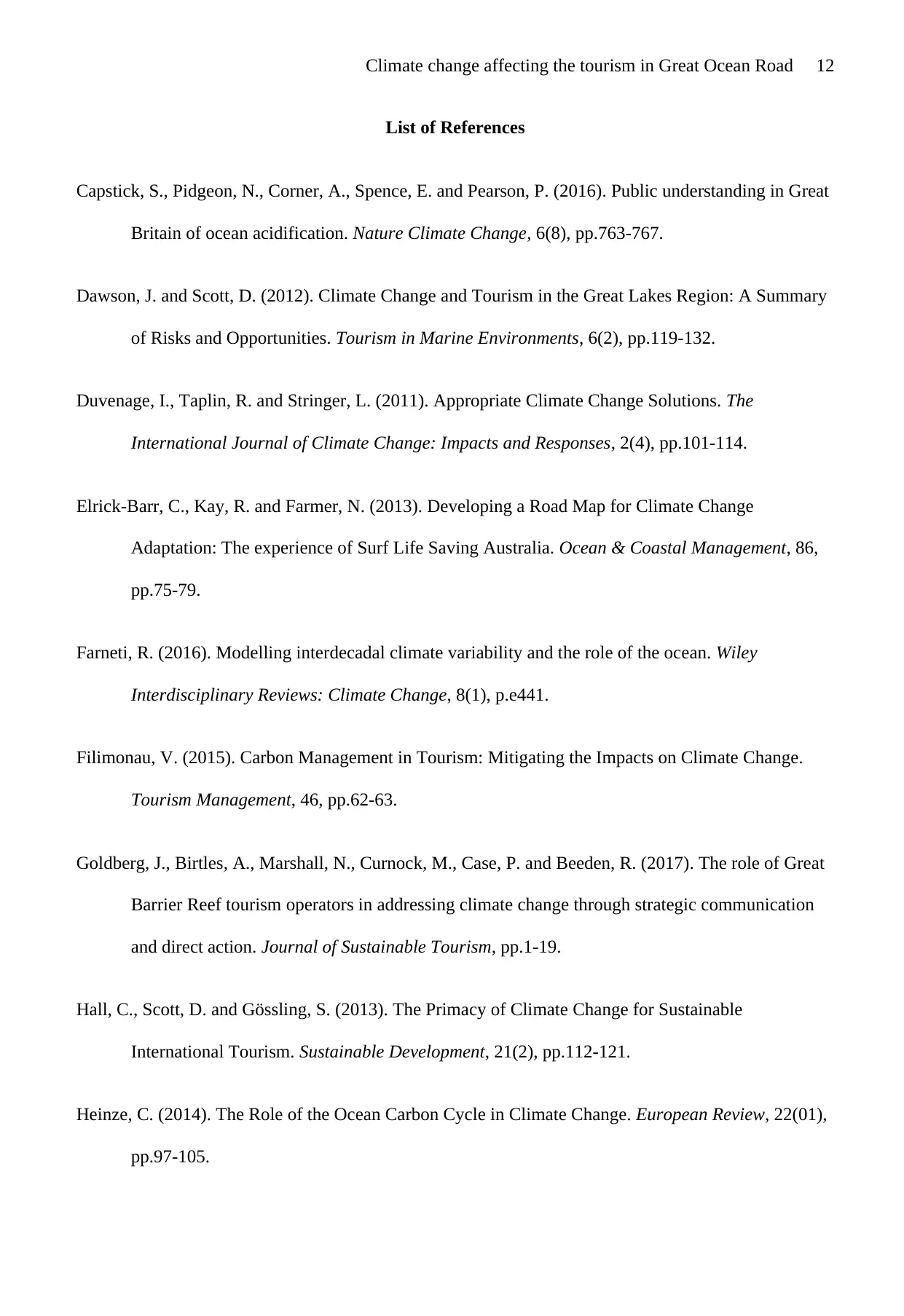
Climate change affecting the tourism in Great Ocean Road 12
List of References
Capstick, S., Pidgeon, N., Corner, A., Spence, E. and Pearson, P. (2016). Public understanding in Great
Britain of ocean acidification. Nature Climate Change, 6(8), pp.763-767.
Dawson, J. and Scott, D. (2012). Climate Change and Tourism in the Great Lakes Region: A Summary
of Risks and Opportunities. Tourism in Marine Environments, 6(2), pp.119-132.
Duvenage, I., Taplin, R. and Stringer, L. (2011). Appropriate Climate Change Solutions. The
International Journal of Climate Change: Impacts and Responses, 2(4), pp.101-114.
Elrick-Barr, C., Kay, R. and Farmer, N. (2013). Developing a Road Map for Climate Change
Adaptation: The experience of Surf Life Saving Australia. Ocean & Coastal Management, 86,
pp.75-79.
Farneti, R. (2016). Modelling interdecadal climate variability and the role of the ocean. Wiley
Interdisciplinary Reviews: Climate Change, 8(1), p.e441.
Filimonau, V. (2015). Carbon Management in Tourism: Mitigating the Impacts on Climate Change.
Tourism Management, 46, pp.62-63.
Goldberg, J., Birtles, A., Marshall, N., Curnock, M., Case, P. and Beeden, R. (2017). The role of Great
Barrier Reef tourism operators in addressing climate change through strategic communication
and direct action. Journal of Sustainable Tourism, pp.1-19.
Hall, C., Scott, D. and Gössling, S. (2013). The Primacy of Climate Change for Sustainable
International Tourism. Sustainable Development, 21(2), pp.112-121.
Heinze, C. (2014). The Role of the Ocean Carbon Cycle in Climate Change. European Review, 22(01),
pp.97-105.
List of References
Capstick, S., Pidgeon, N., Corner, A., Spence, E. and Pearson, P. (2016). Public understanding in Great
Britain of ocean acidification. Nature Climate Change, 6(8), pp.763-767.
Dawson, J. and Scott, D. (2012). Climate Change and Tourism in the Great Lakes Region: A Summary
of Risks and Opportunities. Tourism in Marine Environments, 6(2), pp.119-132.
Duvenage, I., Taplin, R. and Stringer, L. (2011). Appropriate Climate Change Solutions. The
International Journal of Climate Change: Impacts and Responses, 2(4), pp.101-114.
Elrick-Barr, C., Kay, R. and Farmer, N. (2013). Developing a Road Map for Climate Change
Adaptation: The experience of Surf Life Saving Australia. Ocean & Coastal Management, 86,
pp.75-79.
Farneti, R. (2016). Modelling interdecadal climate variability and the role of the ocean. Wiley
Interdisciplinary Reviews: Climate Change, 8(1), p.e441.
Filimonau, V. (2015). Carbon Management in Tourism: Mitigating the Impacts on Climate Change.
Tourism Management, 46, pp.62-63.
Goldberg, J., Birtles, A., Marshall, N., Curnock, M., Case, P. and Beeden, R. (2017). The role of Great
Barrier Reef tourism operators in addressing climate change through strategic communication
and direct action. Journal of Sustainable Tourism, pp.1-19.
Hall, C., Scott, D. and Gössling, S. (2013). The Primacy of Climate Change for Sustainable
International Tourism. Sustainable Development, 21(2), pp.112-121.
Heinze, C. (2014). The Role of the Ocean Carbon Cycle in Climate Change. European Review, 22(01),
pp.97-105.
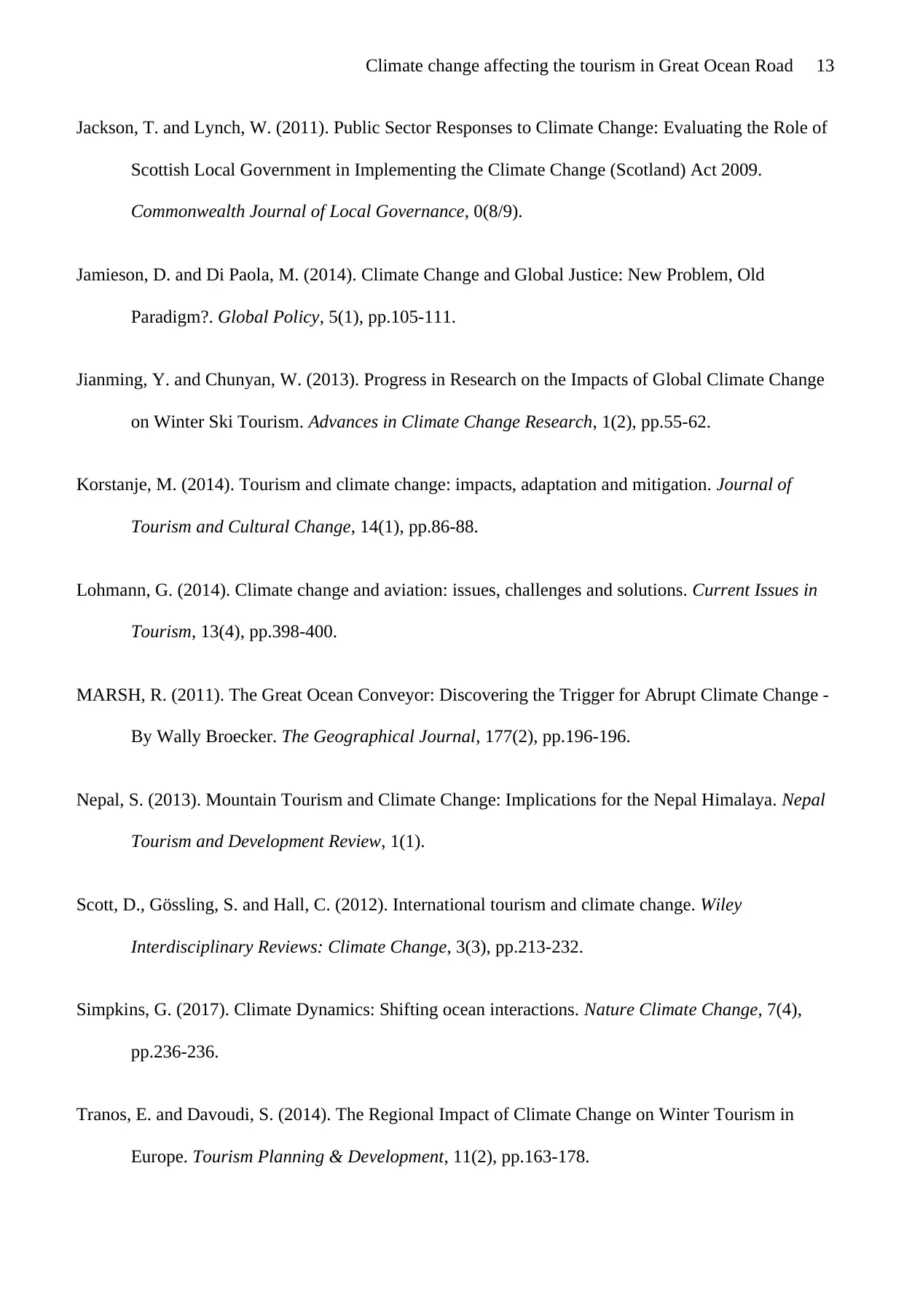
Climate change affecting the tourism in Great Ocean Road 13
Jackson, T. and Lynch, W. (2011). Public Sector Responses to Climate Change: Evaluating the Role of
Scottish Local Government in Implementing the Climate Change (Scotland) Act 2009.
Commonwealth Journal of Local Governance, 0(8/9).
Jamieson, D. and Di Paola, M. (2014). Climate Change and Global Justice: New Problem, Old
Paradigm?. Global Policy, 5(1), pp.105-111.
Jianming, Y. and Chunyan, W. (2013). Progress in Research on the Impacts of Global Climate Change
on Winter Ski Tourism. Advances in Climate Change Research, 1(2), pp.55-62.
Korstanje, M. (2014). Tourism and climate change: impacts, adaptation and mitigation. Journal of
Tourism and Cultural Change, 14(1), pp.86-88.
Lohmann, G. (2014). Climate change and aviation: issues, challenges and solutions. Current Issues in
Tourism, 13(4), pp.398-400.
MARSH, R. (2011). The Great Ocean Conveyor: Discovering the Trigger for Abrupt Climate Change -
By Wally Broecker. The Geographical Journal, 177(2), pp.196-196.
Nepal, S. (2013). Mountain Tourism and Climate Change: Implications for the Nepal Himalaya. Nepal
Tourism and Development Review, 1(1).
Scott, D., Gössling, S. and Hall, C. (2012). International tourism and climate change. Wiley
Interdisciplinary Reviews: Climate Change, 3(3), pp.213-232.
Simpkins, G. (2017). Climate Dynamics: Shifting ocean interactions. Nature Climate Change, 7(4),
pp.236-236.
Tranos, E. and Davoudi, S. (2014). The Regional Impact of Climate Change on Winter Tourism in
Europe. Tourism Planning & Development, 11(2), pp.163-178.
Jackson, T. and Lynch, W. (2011). Public Sector Responses to Climate Change: Evaluating the Role of
Scottish Local Government in Implementing the Climate Change (Scotland) Act 2009.
Commonwealth Journal of Local Governance, 0(8/9).
Jamieson, D. and Di Paola, M. (2014). Climate Change and Global Justice: New Problem, Old
Paradigm?. Global Policy, 5(1), pp.105-111.
Jianming, Y. and Chunyan, W. (2013). Progress in Research on the Impacts of Global Climate Change
on Winter Ski Tourism. Advances in Climate Change Research, 1(2), pp.55-62.
Korstanje, M. (2014). Tourism and climate change: impacts, adaptation and mitigation. Journal of
Tourism and Cultural Change, 14(1), pp.86-88.
Lohmann, G. (2014). Climate change and aviation: issues, challenges and solutions. Current Issues in
Tourism, 13(4), pp.398-400.
MARSH, R. (2011). The Great Ocean Conveyor: Discovering the Trigger for Abrupt Climate Change -
By Wally Broecker. The Geographical Journal, 177(2), pp.196-196.
Nepal, S. (2013). Mountain Tourism and Climate Change: Implications for the Nepal Himalaya. Nepal
Tourism and Development Review, 1(1).
Scott, D., Gössling, S. and Hall, C. (2012). International tourism and climate change. Wiley
Interdisciplinary Reviews: Climate Change, 3(3), pp.213-232.
Simpkins, G. (2017). Climate Dynamics: Shifting ocean interactions. Nature Climate Change, 7(4),
pp.236-236.
Tranos, E. and Davoudi, S. (2014). The Regional Impact of Climate Change on Winter Tourism in
Europe. Tourism Planning & Development, 11(2), pp.163-178.
Paraphrase This Document
Need a fresh take? Get an instant paraphrase of this document with our AI Paraphraser
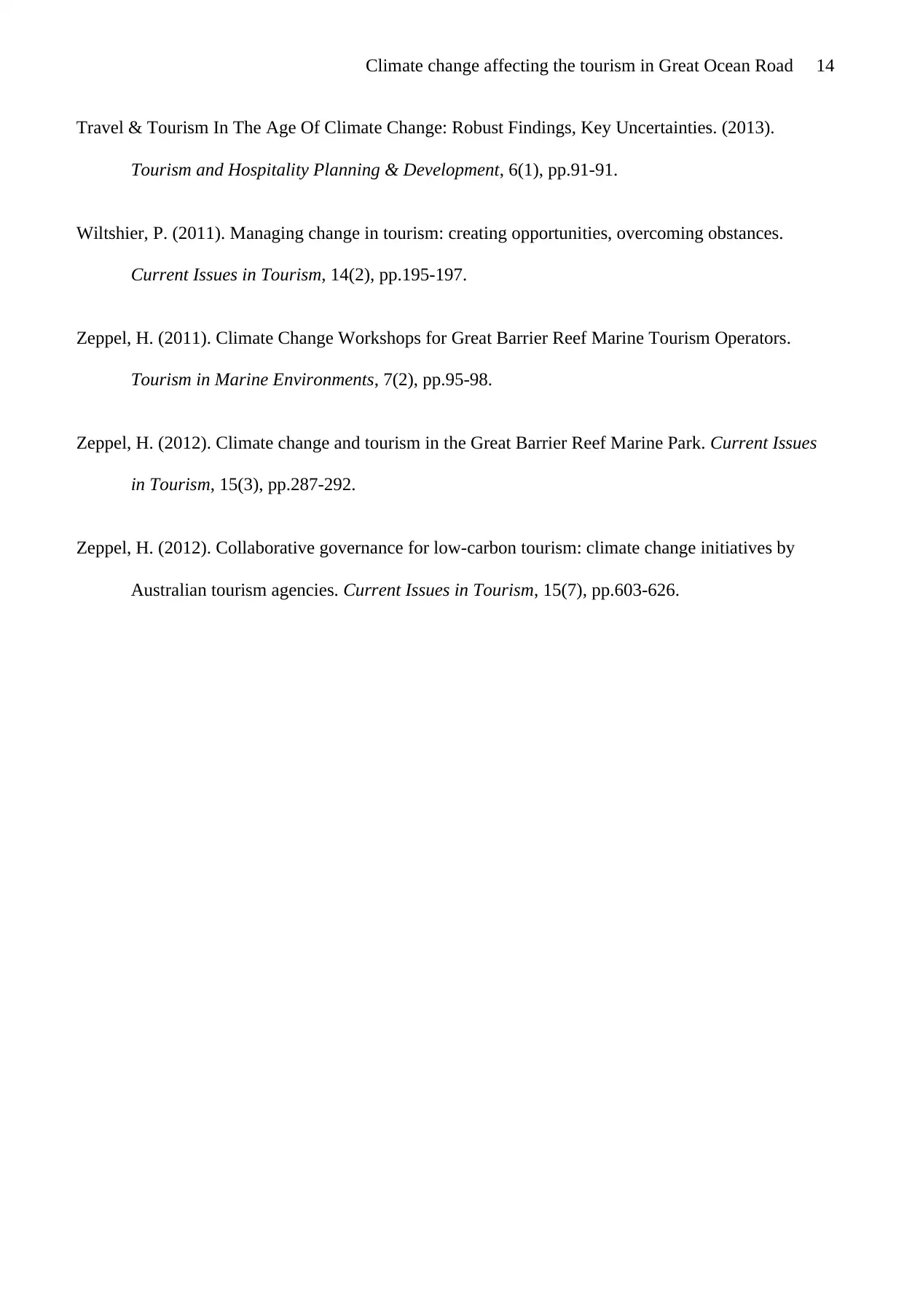
Climate change affecting the tourism in Great Ocean Road 14
Travel & Tourism In The Age Of Climate Change: Robust Findings, Key Uncertainties. (2013).
Tourism and Hospitality Planning & Development, 6(1), pp.91-91.
Wiltshier, P. (2011). Managing change in tourism: creating opportunities, overcoming obstances.
Current Issues in Tourism, 14(2), pp.195-197.
Zeppel, H. (2011). Climate Change Workshops for Great Barrier Reef Marine Tourism Operators.
Tourism in Marine Environments, 7(2), pp.95-98.
Zeppel, H. (2012). Climate change and tourism in the Great Barrier Reef Marine Park. Current Issues
in Tourism, 15(3), pp.287-292.
Zeppel, H. (2012). Collaborative governance for low-carbon tourism: climate change initiatives by
Australian tourism agencies. Current Issues in Tourism, 15(7), pp.603-626.
Travel & Tourism In The Age Of Climate Change: Robust Findings, Key Uncertainties. (2013).
Tourism and Hospitality Planning & Development, 6(1), pp.91-91.
Wiltshier, P. (2011). Managing change in tourism: creating opportunities, overcoming obstances.
Current Issues in Tourism, 14(2), pp.195-197.
Zeppel, H. (2011). Climate Change Workshops for Great Barrier Reef Marine Tourism Operators.
Tourism in Marine Environments, 7(2), pp.95-98.
Zeppel, H. (2012). Climate change and tourism in the Great Barrier Reef Marine Park. Current Issues
in Tourism, 15(3), pp.287-292.
Zeppel, H. (2012). Collaborative governance for low-carbon tourism: climate change initiatives by
Australian tourism agencies. Current Issues in Tourism, 15(7), pp.603-626.
1 out of 14
Related Documents
Your All-in-One AI-Powered Toolkit for Academic Success.
+13062052269
info@desklib.com
Available 24*7 on WhatsApp / Email
![[object Object]](/_next/static/media/star-bottom.7253800d.svg)
Unlock your academic potential
© 2024 | Zucol Services PVT LTD | All rights reserved.




